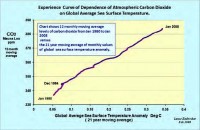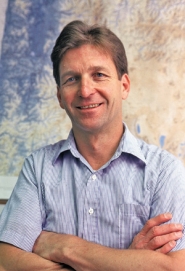
|
Apr 21, 2008
Oceans Are the Main Regulators of Carbon Dioxide
Dr. Lance Endersbee paper published in Engineers Australia magazine
Recent data on global average sea surface temperatures derived from satellite observations has revealed some interesting correlations between sea temperatures and atmospheric carbon dioxide. Figure 1 shows the global average sea surface temperature anomaly since 1980. The anomaly is defined as the departure of the actual temperature from the mean global average for the past century (1901-2000). The data is derived from satellite coverage, and is much more consistent than previous data based on surface measurements. Note the cyclic behaviour and the peak in 1999. There has been overall cooling since 1999. The causes of the cyclic behaviour are not known. The major influences are probably the El Nino and La Nina events, and variations in heat flow on the ocean floor from undersea volcanoes and vents. These factors may be related through a common cause. It is difficult to see any influence of human activity in the variations of sea surface temperatures shown in the chart. The present winter in the northern hemisphere has been the coldest for several decades.

See larger image here
Figure 2 shows the direct relationship between sea surface temperature and carbon dioxide levels in the atmosphere since 1980. It is based on a 21-year moving average of sea surface temperatures, and a 12-month moving average of carbon dioxide levels. As the sea temperature has increased, so has the carbon dioxide level. This reflects the normal solubility relationship between carbon dioxide and water. As the sea temperature increases, the oceans breathe out carbon dioxide into the atmosphere. Thus, if sea surface temperatures now continue to fall, we may expect carbon dioxide levels to decrease. There is strong consistency from December 1984 onwards, which reflects the better accuracy and consistency of the temperature records from satellite data.

See larger image here
Read more here.
Emeritus Professor Lance Endersbee is a past national president of Engineers Australia.
Apr 20, 2008
World’s Oldest Tree Rewrites Climate History, Challenges Global Warming
By Noel Sheppard, Newsbusters
Scientists used to believe the oldest trees on the planet were in North America with ages in the 5,000-year range. Hooey, for a new discovery in Sweden has completely debunked this consensus, resulting in a total rewrite of climate history while bringing into serious question global warming theories espoused by Nobel Laureate Al Gore and his sycophant devotees. Think green media members will be falling over themselves to report this new finding? While you ponder, consider the evidence supplied by the British Telegraph Thursday.
The world’s oldest tree has been found in Sweden, a tenacious spruce that first took root just after the end of the last ice age, more than 9,500 years ago. The tree has rewritten the history of the climate in the region, revealing that it was much warmer at that time and the ice had disappeared earlier than thought. It had been thought that this region was still in the grip of the ice age but the tree shows it was much warmer, even than today, [Prof Leif Kullman at Umea University] says. “Spruces are the species that can best give us insight about climate change,” he says. The summers 9,500 years ago were warmer than today, though there has been a rapid recent rise as a result of climate change that means modern climate is rapidly catching up.
Hmmm. So, as a result of this find, we now know that summers in Sweden were not only much warmer 9,500 years ago than the consensus view used to be, but ALSO warmer than today, even after all that awful carbon dioxide that man has released into the atmosphere in the past couple of centuries.
As a post facto aside, this find should also point out how irrelevant a “consensus” is as it pertains to science, for new discoveries are always debunking and challenging conventional wisdom. Sadly, folks in the media, and climate alarmists looking to stifle debate, refuse to understand this inconvenient truth. That said, energy and financial policies SHOULD NOT be based on supposedly consensus views of science for EXACTLY this reason, for a lot of time, money, and resources could be devoted to a “solution” to a “problem” which ends up NOT existing. Read more here.
Noel Sheppard is an economist, business owner, and Associate Editor of NewsBusters
Apr 19, 2008
Late Snow Gives Scots Resorts a Ski Lift
By Paul Biggs, Jennifer Marohasy Blog
Rumours of the demise of Scottish skiing are beginning to look greatly exaggerated. While many Alpine resorts have closed for the season, thousands of skiers are still enjoying perfect conditions in the Highlands. The CairnGorm ski area above Aviemore expects to remain open into May, putting it in the same category as Val d’Isere, the high French resort.
Scotland’s five resorts have struggled for more than 15 years with the effects of global warming, and several have diversified into summer tourism. The perfect snow cover at CairnGorm this weekend follows the worst season on record last year. There is even talk of skiing on midsummer’s day, as visitors make the most of the best spring snow conditions anyone can remember. Some low-level runs were available during the season that had not been skied for a generation, while internet chatrooms are full of talk about the exceptional conditions.
Acccording to Bob Kinnaird, the chief executive of the CairnGorm ski area remarked “These are the best spring conditions I can remember. It is an extraordinary position for Scottish skiing at this stage in April.” See more here.
Apr 18, 2008
A Round Up of Climate Studies from This Week’s Science Magazine
By Paul Biggs, Jennifermarohasyblog.com
Greenland Ice Slipping Away but Not All That Quickly
Almost 6 years ago, a paper in Science warned of an unheralded environmental peril. Melted snow and ice seemed to be reaching the base of the great Greenland ice sheet, lubricating it and accelerating the sheet’s slide toward oblivion in the sea, where it was raising sea level worldwide (12 July 2002, p. 218).
A new study has confirmed that meltwater reaches the ice sheet’s base and does indeed speed the ice’s seaward flow. The good news is that the process is more leisurely than many climate scientists had feared. Glaciologist Richard Alley of Pennsylvania State University in State College says, “It matters, but it’s not huge.” The finding should ease concerns that Greenland ice could raise sea level a disastrous meter or more by the end of the century.
Coral Adaptation in the Face of Climate Change
In their review, “Coral Reefs Under Rapid Climate Change and Ocean Acidification” (14 December 2007, p. 1737), O. Hoegh- Guldberg et al. present future reef scenarios that range from coral-dominated communities to rapidly eroding rubble banks. Notably, none of their scenarios considers the capacity for corals to adapt. The authors dismiss adaptation because “reef-building corals have relatively long generation times and low genetic diversity, making or slow rates of adaptation [relative to rates of change].” We think the possibility of adaptation deserves a second look.
In the absence of longterm demographic studies to detect temporal trends in life history traits, predicting rates of adaptation, and whether they will be exceeded by rates of environmental change, is pure speculation. Indeed, where such data are available for terrestrial organisms they demonstrate that contemporary evolution in response to climate change is possible. See this story in the Herald Sun, Scientists find corals flourishing on Bikini Atoll. Some corals are again flourishing on Bikini Atoll, the Pacific site of the largest American atom bomb ever exploded, a 15 mega-tonne bomb a thousand times more powerful than the one dropped on Hiroshima in Japan in WWII. It vapourised three islands, raised water temperatures to 55,000 degrees, shook islands 200km away and left a crater 2km wide and 73m deep.
Ms Richards said she did not know what to expect when she dived on the crater but was surprised to find huge matrices of branching Porites coral - up to eight metres high - had established, creating thriving coral reef habitat. “Throughout other parts of the lagoon it was awesome to see coral cover as high as 80 per cent and large tree-like branching coral formations with trunks 30cm thick. “It was fascinating - I’ve never seen corals growing like trees outside of the Marshall Islands.’’ The healthy condition of the coral at Bikini today was proof of the atoll’s resilience and ability to bounce back from massive disturbances if the reef was left undisturbed and there were healthy nearby reefs to source the recovery.’’
Read more here.
Apr 17, 2008
OSU Climatologist Vacates Hot Seat
Interview with Chris Lydgate, Sustainable Life

Sustainable Life: Do you believe in global warming?
George Taylor: Sure. Yeah. Yeah. The temperature of the Earth’s atmosphere varies. But I also believe in global cooling. The Earth’s temperature changes on a variety of time scales. Over a period of months, years, decades, centuries or millennia. So to say it’s warmer or cooler depends on the starting and ending points.
SL: Will it get hotter in the future?
Taylor: It depends on the time scale you’re talking about. In Oregon it will get warmer in the next four months, but it will almost certainly get cooler in the next 5,000 years. We are now enjoying an interglacial period - a period between two ice ages - and these are typically shorter than the cold periods. We came out of the last ice age about 15,000 years ago, and based on what’s happened in the past, it’s logical to conclude that the warm period will terminate in the next 5,000 years.
SL: What about the next hundred years?
Taylor: To answer that, you have to understand what causes climate change. I believe the climate changes as a result of several factors, some natural, some human. Human factors include greenhouse gases, particularly carbon dioxide, but also a host of other effects - deforestation, urbanization, emission of aerosols. Carbon dioxide gets all the headlines, but frankly, I think it is overemphasized. There are also natural factors. Changes in solar radiation, for example - there’s an 11-year cycle, a 20- to 27-year cycle, a 95-year cycle, a 210-year cycle, a 1,500-year cycle, and several more known as Milankovitch cycles, which last tens of thousands of years. Another big influence is the ocean, especially the tropical Pacific. The tropical Pacific is the biggest source of heat for the atmosphere - it has a dominant effect on weather and climate. Volcanic eruptions generate huge amounts of dust that have a profound effect on global temperatures. And then there are things whose role we don’t understand, like clouds - they are usually ignored by climate prediction models. They don’t know how to include them, so they ignore them. Same with El Nino and La Nina.
SL: Even if the models aren’t perfect, shouldn’t we cut carbon emissions now, before it’s too late?
Taylor: Look, if we reduce greenhouse gases in the atmosphere, that will tend to lower the temperature, all other things being equal. The question is how much, and are the other things equal? Those are tough questions to answer. When I look at precipitation, temperature and snowfall in the Northwest, I see stronger correlation with natural factors than with greenhouse gases. So I have concluded that the influence of natural factors on climate is more significant than that of greenhouse gases.
SL: How much more significant?
Taylor: I hesitate to put a number on it. But it’s a lot more than 50-50.
Read more about George vacating his position at OSU and the rest of the interview here.
Icecap Note: Oregon and OSU are the big losers here. But thankfully George now will be able to speak out freely and Icecap would welcome his blogs and papers and bring them to you whenever we can.
|
|
|
|





